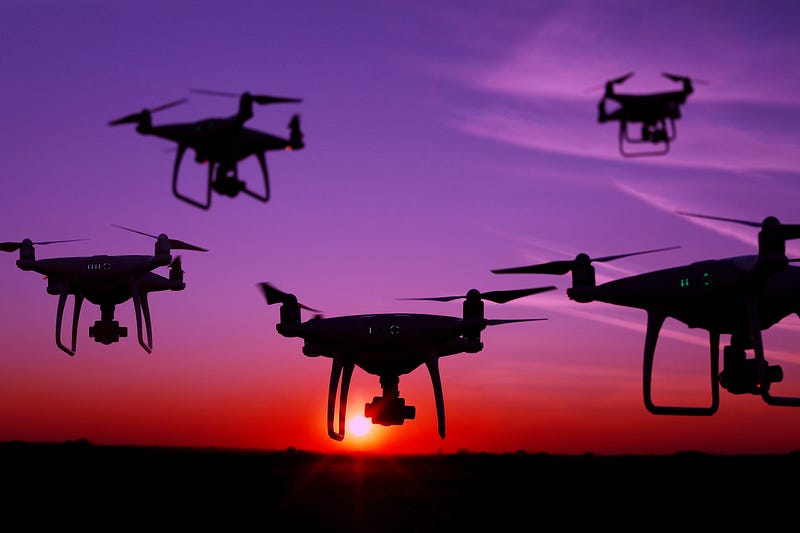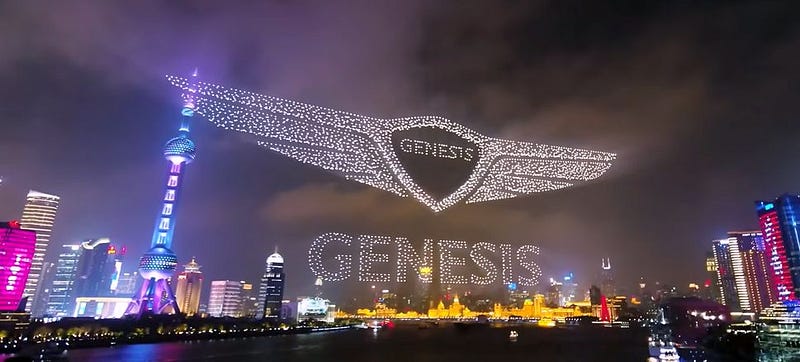Drone Swarms: The Future of Marketing and Mass Destruction
Written on
Chapter 1: The Intersection of Drones and Advertising
Drones have emerged as powerful tools in guerrilla marketing, but their applications extend far beyond mere advertising.

Image by Marco Verch, licensed under CC 2.0
What parallels can be drawn between drones and QR codes?
One notable instance occurred in Shanghai, where to mark the first anniversary of the Princess Connect! Re: Dive RPG in China, Bilibili orchestrated an extraordinary light drone display on April 17. This event featured over 1,500 drones creating mesmerizing animations of beloved game characters, culminating in a gigantic, scannable QR code that directed viewers to download the game.
While many media outlets compared this spectacle to the commercialization depicted in Blade Runner, it’s important to recognize that many sci-fi visions have been realized through ongoing technological advancements.
This isn’t just any run-of-the-mill advertisement that can be easily replicated. The intent behind this event was undoubtedly to provoke reactions and generate buzz—a strategic guerrilla marketing tactic.
What Exactly is Guerrilla Marketing?
Guerrilla marketing is an innovative advertising approach that is characterized by several key elements:
- It surprises consumers.
- It utilizes unconventional methods to promote products or services.
- It aims to create memorable experiences and conversations.
- It is typically cost-effective.
- It emphasizes broad reach over repetitive exposure.
- It thrives on creativity, energy, and time.
The impressive light show for Princess Connect fits squarely within the realm of street marketing, infused with elements of viral marketing. Other notable examples of guerrilla marketing include UNICEF's Dirty Water stunt for their Tap Water campaign, Coca-Cola's Grip Bottle initiative utilizing Velcro posters, and Jeep’s Parking Space campaign in Copenhagen.
What is Drone Swarm Technology?
Drone swarms, or fleets, consist of multiple drones working in concert to achieve specific objectives. Their uses span various fields, including military surveillance, environmental assessment, disaster response, and even advertising through light displays.
While the light drone show in Shanghai might seem groundbreaking, it was not entirely novel; the incorporation of a QR code merely enhanced its appeal. We’ve seen similar performances before, particularly with Intel’s Shooting Star technology, which has dazzled audiences at numerous high-profile events, including:
- Launching 500 drones in 2016 to set a world record.
- Collaborating with Warner Bros for the Wonder Woman film in 2017.
- Performing at the Olympic Winter Games in South Korea in 2018.
- Showcasing synchronized indoor drone flights during the 2019 Super Bowl.
- Streaming a special holiday light show for Walmart in 2020.
Currently, the record for the most drones airborne simultaneously belongs to Genesis Motor Sales, which achieved an astonishing 3,281 drones in Shanghai on March 29, 2021.

Screenshot from GenesisChina’s YouTube video “Brand Night”
While researching drone swarm technology and its potential beyond advertising, I found that many discussions surrounding this technology often invoke themes of warfare and mass destruction.
All disruptive technologies can be used for both positive and negative purposes. When new technologies emerge, military applications are often explored, especially when they do not originate from military research, as seen with the internet’s development through DARPA.
Reflecting on the internet, it has allowed for advertising proliferation, leading to oversaturation and new threats like cyberattacks. The duality of technology raises questions: how does valuable medical research coexist with the looming threat of biological weapons?
Consider how fireworks and firearms share similar principles, and how mechanization has provided us both with essential vehicles and military tanks. Furthermore, nuclear energy has transitioned from a seemingly ecological power source to one of humanity’s most devastating weapons—the atomic bomb.
As we witness the rise of digital fireworks (or shooting stars), let's hope to utilize them for entertainment and awareness, postponing any fears of mass destruction indefinitely.
To delve deeper into the recent drone light show and its implications for mass marketing, check out Youssef Ragab's insightful article:
The QR Code in the Sky A glimpse into the future of marketing?
bettermarketing.pub
Chapter 2: Insights on Future Warfare and Drone Technology
In this episode of the Bullaki Science Podcast, David Hambling discusses the implications of drone technology on future warfare, highlighting both its potential and risks.
Chapter 3: Drone Swarms and Information Warfare
The Decisive Point Podcast features Zachary Kallenborn discussing "InfoSwarms," examining the intersection of drone swarms and information warfare, emphasizing how this technology can reshape modern conflict.